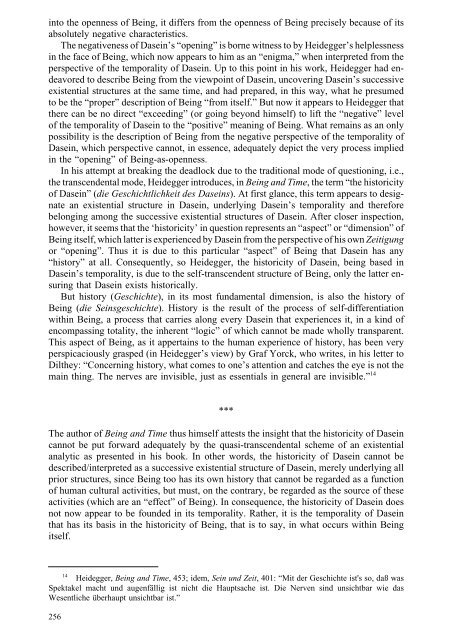[Andrzej_Wiercinski_(ed ... - WordPress.com
[Andrzej_Wiercinski_(ed ... - WordPress.com
[Andrzej_Wiercinski_(ed ... - WordPress.com
Create successful ePaper yourself
Turn your PDF publications into a flip-book with our unique Google optimized e-Paper software.
into the openness of Being, it differs from the openness of Being precisely because of itsabsolutely negative characteristics.The negativeness of Dasein’s “opening” is borne witness to by Heidegger’s helplessnessin the face of Being, which now appears to him as an “enigma,” when interpret<strong>ed</strong> from theperspective of the temporality of Dasein. Up to this point in his work, Heidegger had endeavor<strong>ed</strong>to describe Being from the viewpoint of Dasein, uncovering Dasein’s successiveexistential structures at the same time, and had prepar<strong>ed</strong>, in this way, what he presum<strong>ed</strong>to be the “proper” description of Being “from itself.” But now it appears to Heidegger thatthere can be no direct “exce<strong>ed</strong>ing” (or going beyond himself) to lift the “negative” levelof the temporality of Dasein to the “positive” meaning of Being. What remains as an onlypossibility is the description of Being from the negative perspective of the temporality ofDasein, which perspective cannot, in essence, adequately depict the very process impli<strong>ed</strong>in the “opening” of Being-as-openness.In his attempt at breaking the deadlock due to the traditional mode of questioning, i.e.,the transcendental mode, Heidegger introduces, in Being and Time, the term “the historicityof Dasein” (die Geschichtlichkeit des Daseins). At first glance, this term appears to designatean existential structure in Dasein, underlying Dasein’s temporality and thereforebelonging among the successive existential structures of Dasein. After closer inspection,however, it seems that the ‘historicity’ in question represents an “aspect” or “dimension” ofBeing itself, which latter is experienc<strong>ed</strong> by Dasein from the perspective of his own Zeitigungor “opening”. Thus it is due to this particular “aspect” of Being that Dasein has any“history” at all. Consequently, so Heidegger, the historicity of Dasein, being bas<strong>ed</strong> inDasein’s temporality, is due to the self-transcendent structure of Being, only the latter ensuringthat Dasein exists historically.But history (Geschichte), in its most fundamental dimension, is also the history ofBeing (die Seinsgeschichte). History is the result of the process of self-differentiationwithin Being, a process that carries along every Dasein that experiences it, in a kind ofen<strong>com</strong>passing totality, the inherent “logic” of which cannot be made wholly transparent.This aspect of Being, as it appertains to the human experience of history, has been veryperspicaciously grasp<strong>ed</strong> (in Heidegger’s view) by Graf Yorck, who writes, in his letter toDilthey: “Concerning history, what <strong>com</strong>es to one’s attention and catches the eye is not themain thing. The nerves are invisible, just as essentials in general are invisible.” 14***The author of Being and Time thus himself attests the insight that the historicity of Daseincannot be put forward adequately by the quasi-transcendental scheme of an existentialanalytic as present<strong>ed</strong> in his book. In other words, the historicity of Dasein cannot b<strong>ed</strong>escrib<strong>ed</strong>/interpret<strong>ed</strong> as a successive existential structure of Dasein, merely underlying allprior structures, since Being too has its own history that cannot be regard<strong>ed</strong> as a functionof human cultural activities, but must, on the contrary, be regard<strong>ed</strong> as the source of theseactivities (which are an “effect” of Being). In consequence, the historicity of Dasein doesnot now appear to be found<strong>ed</strong> in its temporality. Rather, it is the temporality of Daseinthat has its basis in the historicity of Being, that is to say, in what occurs within Beingitself.14Heidegger, Being and Time, 453; idem, Sein und Zeit, 401: “Mit der Geschichte ist's so, daß wasSpektakel macht und augenfällig ist nicht die Hauptsache ist. Die Nerven sind unsichtbar wie dasWesentliche überhaupt unsichtbar ist.”256


